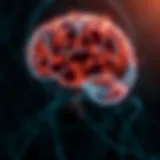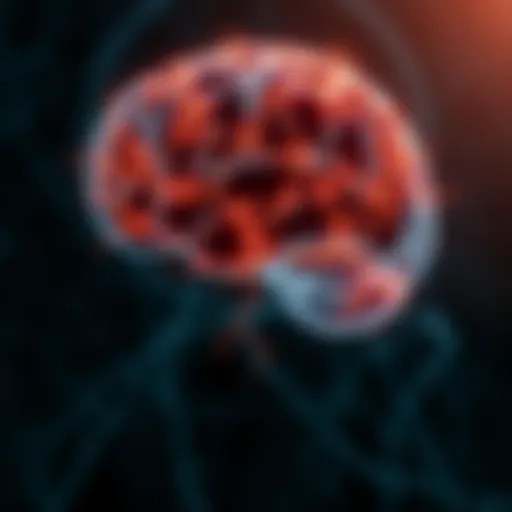Understanding Mild Anorexia Disorder: Symptoms and Insights


Intro
Understanding mental health is crucial when addressing various conditions like mild anorexia disorder. Many individuals may struggle with the complexities of eating disorders, making it hard to connect with deeper issues related to self-worth, body image, and overall mental well-being. This exploration aims to shed light on mild anorexia disorder, its symptoms, and what makes it distinct from more severe forms of anorexia.
Understanding Mental Health and Well-being
What is Mental Health?
Mental health refers to our emotional, psychological, and social well-being. It affects how we think, feel, and behave. Understanding mental health is especially vital for grasping the development of disorders such as mild anorexia because it intertwines with every aspect of our lives. Conditions like anxiety and depression overlap frequently with eating disorders.
The Importance of Prioritizing Mental Well-being
Prioritizing mental well-being encompasses recognizing the signs of distress and intervening early. Poor mental health can lead to a spiral of harmful behaviors, particularly for those with mild anorexia. Therefore, understanding one’s emotional state is crucial for quality of life. Simple acts such as journaling, talking to friends, or pursuing hobbies can create a positive mental space.
Common Mental Health Challenges and Disorders
Numerous mental health challenges affect individuals, including:
- Anxiety Disorders
- Major Depressive Disorder
- Eating Disorders such as Anorexia and Bulimia
- PTSD (Post-Traumatic Stress Disorder)
Mild anorexia sits on the spectrum of eating disorders, often slipping under the radar compared to more severe cases. Its impact on the individual can be heart-wrenching, with implications that extend beyond just feeding habits.
Symptoms of Mild Anorexia Disorder
Mild anorexia occurs when eating behaviors still predominantly impact life but have not reached a critical state. Common symptoms may include significant preoccupation with food, caloric intake, and extreme self-criticism about body image. Unlike severe cases, those with mild anorexia may not present stark physical changes, making detection challenging.
Individuals might maintain normal weight yet undergo changes in mood and behavior. Early intervention is critical since symptoms can worsen. If you or someone you know has traces of these behaviors, consider initiating conversations and seeking help.
Causes of Mild Anorexia
Various factors lead to the emergence of mild anorexia disorder, including:
- Genetic Predispositions: Family histories of eating disorders may increase risks.
- Sociocultural Influences: Societal standards of beauty can significantly impact self-perception.
- Psychological Factors: Low self-esteem, perfectionism, and anxiety often contribute to this disorder.
Understanding these roots can lead to more effective prevention strategies while fostering a healthy environment that encourages openness.
Treatment Options and Prevention Strategies
Addressing mild anorexia requires tailored approaches. Some recommended treatment options include:
- Nutritional Counselling to promote balanced dietary habits.
- Individual Therapy focusing on cognitive behavioral techniques.
- Support Groups for shared experiences and community support.
Prevention is often about education and communication. Engaging young individuals in discussions about body image, emphasizing positive reinforcement, and valuing the diversity of body shapes can mitigate risks of developing eating disorders.
Importance of Professional Support
Seeking professional help is a pivotal step for individuals diagnosed with any form of eating disorder, including mild anorexia. Accepting the condition is often a journey filled with emotions. Counseling offers coping tools geared toward warping negative thoughts and fostering positive emotions. As @Bert Johnson, a clinical psychologist notes: > Mental health support can act as a stabilizer for emotions and create a safety net for recovery practices.
Creating a support system inclusive of friends, family, and professionals can propel effective healing. Maintaining honest openness allows vulnerable dialogues that are essential for recovery and management.
By understanding mild anorexia better, individuals can navigate conversations that highlight emotions, cultivate resources, and affirm – every voice matters.
Prelude to Mild Anorexia Disorder
Mild anorexia disorder represents a subtler facet of eating disorders, often overlooked yet significant in its impact. Understanding this condition is imperative, as it affects individuals physically, emotionally, and socially. In this section, the focus will be primarily on defining mild anorexia, and examining its context in a broader framework of mental health.
Defining Mild Anorexia
Mild anorexia can be challenging to define because its characteristics may blend with typical dieting behaviors. Generally, it involves an unhealthy preoccupation with food, body image, and weight control, but without the severe manifestations typical of full-blown anorexia nervosa. People may not reach the critical weight threshold that categorizes anorexia nervosa but still exhibit significant unhealthy traits, such as restrictive eating practices or excessive exercise. Individuals with mild anorexia may avoid certain food groups or continuously count calories. This can lead to nutritional deficiencies affecting overall health.
While some aspects are subtle, the detrimental consequences of mild anorexia can escalate if not addressed. Emotional turmoil, low self-esteem, and anxiety about eating situations may arise. People may also experience social withdrawal as their condition pushes them away from normal eating patterns with friends and family. This makes defining mild anorexia especially urgent to prevent further complications.
Understanding its Context
To truly grasp mild anorexia, one must consider the social and cultural contexts that shape its emergence. Societal pressure to conform to narrow standards of beauty is pervasive. Media and public discourse around body image significantly influence both young and old individuals. This societal backdrop creates fertile ground for mild anorexia to develop. Lifestyles that devalue physical appearance can fortify disordered eating habits and promote body dissatisfaction.
Furthermore, environmental elements such as personal history and social dynamics contribute immensely to the onset of mild anorexia. Family influences, feeding patterns, and peer interactions play vital roles in shaping an individual's relationship with food and body image. Often, these contextual understandings reveal the multilayered nature of mild anorexia, underscoring its complexity beyond mere behavioral symptoms.
In summary, acknowledging the context and defining features of mild anorexia disorder form the foundation for deeper insights into its implications and triggers. Addressing this phenomenon is not just important for those who are affected but also for mental health professionals aiming to provide necessary support and intervention.
Symptoms of Mild Anorexia Disorder
Understanding the symptoms of mild anorexia disorder is critical for proper diagnosis and treatment. Identifying these signs early can significantly improve outcomes. The manifestation of symptoms may vary from person to person and can be subtle at times, making it essential to understand the specific elements associated with this disorder. Recognizing these indicators can facilitate earlier intervention, leading to more effective management of the condition.
Behavioral Indicators
Behavioral indicators are some of the first signs to emerge in individuals with mild anorexia disorder. Changes in eating habits often become apparent before any other symptoms. A person may start to show an obsessive focus on food, dieting, or body image. For instance, they may begin to refuse meals, obsess over calorie intake, or frequently skip meals in social settings.
Common behavioral signs include:
- Restrictive eating patterns such as limiting calories or certain food types.
- Preoccupation with weight and body size, leading to persistent comments about their weight.
- Avoidance of meals or eating in solitude to hide their eating habits.
- Extreme exercise regimens may also develop as a way to compensate for food intake.
Being aware of these shifts can help friends or family support the individual by suggesting professional guidance or being more understanding about their behavior.
Physical Symptoms
Physical symptoms of mild anorexia disorder are vital indicators that can affect the person's overall well-being. They might begin their journey exhibiting mild physical changes that develop as the disorder progresses. Some of these symptoms may become severe if not addressed, but in the case of mild anorexia, such changes can initially remain subtle.
Typical physical signs may include:
- Weight loss, although not as severe as seen in full-blown anorexia.
- Hungry but not eating, may lose interest in meals.
- Physical exhibits like brittle hair and nails, which occur due to nutritional deficiency.
- Menstrual irregularities in females due to disrupted hormonal balance.
Monitoring physical health plays an essential role not just for diagnosis but in understanding how the disorder can slowly undermine greater health.
Emotional Challenges


The emotional impact of mild anorexia disorder can often be the most insidious aspect of the condition, accumulating over time and affecting various aspects of life. Individuals may grapple with feelings of inadequacy or low self-esteem that stem from societal pressures to maintain an ideal body image.
Notable emotional challenges include:
- Anxiety related to food choices, meal times, or even body weight.
- Depression often associated with isolation or feelings of guilt regarding eating behaviors.
- A multi-day obsession with control can exacerbate fear of weight gain, leading to extreme feelings of paranoia or obsession.
These emotional hurdles not only influence relating personally to oneself but can complicate interactions with others. Recognizing these challenging feelings is essential in providing the necessary support that can direct individuals toward recovery.
Early recognition and intervention can make a significant difference in effectively managing mild anorexia disorder and its repercussions.
By delving into these symptoms, it becomes easier to unearth underlying issues and facilitate open discussions around mental health, thus paving the way for healing and understanding.
Causes and Risk Factors
Understanding the causes and risk factors of mild anorexia disorder is essential. This knowledge aids in recognizing patterns and behaviors before they escalate into more severe eating disorders. Identifying these elements is crucial for early intervention, which could significantly alter an individual's trajectory toward recovery. Furthermore, recognizing the interplay of these factors helps in designing effective treatment protocols. A well-rounded approach centered on these causes ensures a comprehensive understanding of the disorder as complex and multifactorial, rather than simply a mental or physical issue.
Genetic Influences
Genetics play a vital role in the development of mild anorexia disorder. Individuals with a family history of eating disorders may be more susceptible to developing such conditions. Specific genetic markers, which can be studied further, suggest that certain people may have predispositions toward behaviors associated with anorexia.
Research indicates that genetic factors influence personality traits and biological responses to food. Traits such as perfectionism, anxiety, and impulsivity often found among individuals with anorexia may, in fact, have hereditary aspects.
Key Considerations:
- Family history can highlight increased risk.
- Susceptibility to certain personality traits due to genetics.
- Biological processes can heighten risk through gene-environment interaction.
Environmental Triggers
Environmental factors can significantly trigger mild anorexia disorder. The surroundings, societal expectations, and cultural pressures play a crucial role in shaping one's views on body image and self-worth. For instance, exposure to thin ideals in media fosters unrealistic body standards. Such influences can provoke feelings of inadequacy and drive unhealthy eating habits.
Moreover, life transitions such as moving to a new place, starting a new job, or changes in personal relationships can precipitate old patterns or new fears around food. These triggers are often rooted in external pressures, making them key points of concern for understanding this disorder.
Important Triggers:
- Societal and cultural pressures surrounding body ideals.
- Major life events that can induce stress and anxiety.
- Situational factors like peer behavior regarding food and weight.
Psychological Factors
Psychological factors constitute another essential aspect in understanding mild anorexia disorder. Emotions like low self-esteem, anxiety, and depression can greatly influence one's relationship with food and body image. For many people, how they feel can dominate their eating behaviors.
The drive for control is often significant as well. For individuals feeling overwhelmed by life, manipulating food intake may create a sense of agency where there was none. Unpacking these psychological elements can reveal underlying issues that perpetuate the disorder and guide therapeutic practices to address them effectively.
Common Psychological Influences:
- Low self-esteem regarding body image.
- Feelings of anxiety and depression.
- The need for control in unpredictable environments.
Recognizing the multifaceted causes and risk factors of mild anorexia disorder not only enhances comprehension but also fosters alignment in treatment methods aimed at improving mental health outcomes.
Mild Anorexia vs.
Other Eating Disorders
Mild anorexia disorder exists within a complex landscape of eating disorders. This section examines its distinct features in comparison to other conditions like anorexia nervosa and bulimia. An understanding of these distinctions is critical in developing appropriate treatment and support for individuals experiencing these disorders.
Differentiating from Anorexia Nervosa
Mild anorexia disorder and anorexia nervosa may share some symptoms, but they are classified differently. In patients with anorexia nervosa, there is a significant loss of body weight and an intense fear of gaining weight. This fear dictates their behavior and often leads to drastic measures to control body weight, including extreme dietary restrictions.
Mild anorexia, on the other hand, is characterized by a less severe disturbance in eating behaviors and body weight. Individuals may experience body image issues but often maintain a more moderate weight compared to those with anorexia nervosa. It is important to recognize that while the fear of weight gain is present in both disorders, its intensity and impact on mental functions are markedly different in anorexia nervosa.
Patients with mild anorexia often do not engage in the same level of distress or compulsive behaviors that define anorexia nervosa. Understanding these differences can aid mental health professionals in designing tailored treatment plans which better match the needs of affected individuals.
Comparing with Bulimia
Bulimia nervosa creates a different profile of symptoms compared to both mild anorexia and anorexia nervosa. The primary difference lies in the behavior related to food intake. In bulimia, individuals may consume large quantities of food in a short time—called binge eating—followed by compensatory actions such as purging or excessive exercise to prevent weight gain.
In contrast, a person with mild anorexia employs restrictive eating patterns but is less likely to engage in binge-purge cycles. This avoidance often results in skipped meals or low caloric intake rather than cyclic overeating followed by purging.
Beyond behavioral differences, the emotional challenges and relationship with food also vary. While individuals with bulimia often experience guilt or shame post-binge, those with mild anorexia might simply derive a sense of accomplishment from adherence to strict dietary habits. These nuances require focused understanding to adequately assist those affected by either disorder.
Exploring Other Related Disorders
Several other eating disorders share similarities with mild anorexia, such as atypical anorexia and binge eating disorder. Atypical anorexia presents symptoms akin to anorexia nervosa without the weight loss, complicating its diagnosis yet aligning it closer to mild anorexia.
Binge eating disorder embodies features opposite to those found in mild anorexia. Here, individuals repeatedly consume disproportionate amounts of food, often in relation to emotions rather than physiological hunger. Moreover, conditions like avoidant/restrictive food intake disorder further illustrate the spectrum of eating disorders based on restrictive eating patterns.
Addressing the overlap and distinctions of mild anorexia with these related disorders is vital in providing correct labelings which influence prospective treatment path. Relevant distinctions ensure targeted educational efforts and clearer accessibility to supportive resources.
Understanding the nuances between mild anorexia and other eating disorders fosters compassionate, informed practices in care and treatment.
Implications of Mild Anorexia Disorder
The implications of mild anorexia disorder extend beyond the immediate effects on an individual's physical and mental health. Recognizing the multifaceted nature of this condition is essential for better management and treatment. It has not only personal repercussions but societal ones too. Comprehending these implications provides insights into the critical need for awareness, prevention, and supportive environments that acknowledge the complexities of mild anorexia.
Physical Health Consequences
Mild anorexia can lead to various physical health issues, though often less severe than those associated with more pronounced eating disorders.
- Malnutrition: Even at milder stages, poor nutrition can result. This happens when individuals restrict caloric intake or avoid certain food groups, leading to deficiencies in essential nutrients.
- Weakened immune system: Inadequate nutritional intake can impair the immune response, making individuals more susceptible to infections and illnesses.
- Cardiovascular problems: Low nutritional status can increase heart rate variability and potentially lead to complications in cardiac health.
Additionally, lower bone density may develop as a consequence, increase risk of both fractures and osteoporosis, usually found in more severe eating disorders. Maintaining a stable weight and balanced diet is critical in mitigating these risks, an aspect often emphasized in treatment plans.
Mental Health Implications
The psychological effects of mild anorexia disorder can be profound, affecting both self-esteem and emotional well-being. Early intervention can help prevent further escalation of these issues.


- Anxiety and depression: Often, individuals with mild anorexia experience heightened levels of anxiety concerning body image and food choices. This can lead to depressive symptoms or depressive disorders, particularly if addressing underlying insecurities.
- Perfectionism: Many may develop perfectionistic tendencies, striving for unattainable body ideals, which can further exacerbate mental distress.
- Isolation: Maintaining restrictive eating patterns can contribute to social isolation, as individuals might avoid situations involving meals or social gatherings.
Recognizing these implications early can' facilitate timely adjustments to counteract the mental health challenges that come hand-in-hand with this disorder.
Impact on Daily Life
Mild anorexia disorder can significantly disrupt an individual’s daily life, affecting social relationships, productivity, and overall lifestyle. Throughout life, several key issues are prominent:
- Academic or job performance: Focusing excessively on food and weight can consume mental energy, drawing attention away from responsibilities such as school or work obligations.
- Social interactions: Social situations frequently involve food, making gatherings challenging or even uncomfortable. Individuals may find themselves declining invitations to stay true to their food restrictions.
- Body image perceptions: An obsession with appearance can overshadow daily tasks, increasing the difficulty of functioning normally in a society that places high value on looks.
Given their implications, it is essential that individuals with mild anorexia are understood, to help promote healthier coping strategies and overall support as they navigate these challenges.
Diagnosis and Assessment
Diagnosing and assessing mild anorexia disorder is a critical process. This serves as the foundation for effective intervention and management. Misunderstandings or overlooking symptoms can lead individuals down a challenging path. Therefore, recognizing signs early can aid in timely support. A detailed assessment provides clarity on a patient's condition. Evaluation also involves understanding the person’s unique symptoms. This process is more than just noting weight. It includes evaluating behavior, emotional state and, support structures.
Recognizing Symptoms
Recognizing symptoms of mild anorexia is the first step in addressing this disorder. Symptoms tend to vary widely among individuals, requiring a comprehensive approach. Someone might exhibit a fixation on food and weight, restricting caloric intake while maintaining a semblance of normalcy in daily life. Behavioral indicators can manifest in various ways:
- Avoidance of meals or social eating situations.
- Excessive exercise to control weight, even when weak or fatigued.
- Extreme focus on weight and a distorted body image leading to anxiety compared to body perception.
Other indicatorsd can present in emotional changes. Individuals may withdrawal from social interactions, becoming increasingly isolated. Vigilance in noticing these behaviors can support early detection. Overall, professionals seek both physical and psychological signs to structure a clearer understanding of an individual's health.
Professional Evaluation
Professional evaluation is an essential step once symptoms are identified. Engaging with healthcare providers helps in collating data that forms the basis for diagnosis. Professionals typically use assessment tools, structured interviews, and questionnaires tailored to understand eating patterns and behaviors thoroughly.
Evaluators might delve deeper into:
- Patient’s medical history and previous mental health conditions.
- Family history of eating disorders.
- Psychological assessments to gauge aspects like resilience and stress reactions.
Skilled nutritional evaluation plays a vital role as well. A registered dietitian may offer calculated insights relatingto mindful eating habits. This evaluation should focus on overall health rather than volume of food alone. Careful disscussion between mental health professionals and other evaluators ultimately chairs whther can significantly impact interventions provided to individuals addressing mild anorexia.
Effective evaluation integrates both psychological and physical forensic analysis into an individual level plan utilizing various systematically derived approaches.
With appropriate recognition and evaluations in place, individuals can receive before-becontinue care Like treatment options tailored to help in overall balance and recovery.
Treatment Options for Mild Anorexia
Understanding the various treatments available for mild anorexia disorder is essential for effective management and recovery. This section focuses on specific elements, benefits, and considerations that play a significant role in the treatment journey.
Psychotherapy Approaches
Psychotherapy is often a cornerstone in the treatment of mild anorexia. It helps individuals explore the underlying emotional and psychological factors contributing to their condition. Different approaches could be tailored to meet personal needs. For example, Cognitive Behavioral Therapy (CBT) aims to change negative thought patterns related to food and body image. Familiarizing individuals with healthier coping mechanisms can result in improvement.
Another method, Dialectical Behavior Therapy (DBT), can be effective especially when emotional dysregulation is a component of the disorder.
Research shows that integrating multiple therapeutic techniques often yields the best results.
Besides individual sessions, group therapy can also be beneficial. It allows individuals to connect with others facing similar challenges, fostering a sense of community. In this supportive environment, sharing experiences may ease feelings of isolation and shame.
Benefits of Psychotherapy
- Enhances self-awareness
- Provides strategies for emotional regulation
- Improves emotional resilience
- Fosters a supportive communal network
Considering these aspects underscores the importance of psychotherapy as an effective treatment option for mild anorexia.
Nutritional Guidance
Nutritional guidance serves as another key aspect of managing mild anorexia. This approach focuses on educating individuals about healthy eating habits. Registered dietitians can design personalized meal plans, addressing the unique nutritional needs of those individuals while considering the specific restrictions or fears related to food.
Education is vital here. Many individuals struggle with understanding proper nutrition and the role of various food groups, which deepens their disorder. Thus, a well-structured dietary approach helps in overcoming these misconceptions. Encouraging gradual intake of foods can build confidence and promote recovery.
Key Components of Nutritional Guidance
- Structure a balanced diet: Outline necessary macronutrients and micronutrients.
- Monitor food intake: Establish a plan that includes regular meals and snacks.
- Introduce flexible eating habits: Practicing adaptability in choices encourages healthier relationships with food.
Overall, the goal is to restore a positive relationship with food while addressing any fears and promoting long-term well-being.
Support Systems
Having a robust support system is crucial in the recovery process for mild anorexia. Friends and family can offer emotional support, which is vital for instilling confidence during treatment. Encouragement from loved ones can create an atmosphere of trust, allowing the affected individual to express feelings and concerns about their challenges openly.
Healthcare professionals, including therapists and dietitians, form a significant part of this support structure. They guide the treatment and ensure individuals feel they are not alone. Emotional support will alleviate anxiety or fear surrounding recovery.
Building a Supportive Environment
- Engage family members: Include them in therapy sessions or counseling, if comfortable.
- Establish peer groups: Group activities can foster an encouraging atmosphere since members relate to each other's experiences.
- Advocacy: Friends or family members can help in understanding the disorder better, which mitigates misunderstanding and enhances compassion.
To summarize, the treatment options for mild anorexia disorder encompass a multidimensional approach involving psychotherapy, nutritional guidance, and robust support systems. Such comprehensive strategies are fundamental towards fostering recovery and well-being.
Prevention Strategies
Preventing mild anorexia disorder deals with a few vital elements. First, understanding risk factors is key. Awareness enables families and friends to see early signs. Knowing how to respond can reduce the risk of developing severe symptoms. Healthy practices around food and body perception can also help protect against this disorder.
Benefits of prevention include not just improved mental health but also a greater quality of life. Individual self-esteem can improve, leading to healthier relationships with food and others. A focus on prevention supports lifelong wellness and decreases the complexity of developing more serious eating disorders.
Early intervention is often the most effective way to avoid serious consequences.
Promoting Healthy Body Image
Promoting a healthy body image establishes a solid foundation. Picture this: when individuals feel positive about their appearance, it enhances their self-worth. Young people particularly need this support during formative years.
Strategies to promote a healthy body image might include:


- Education on diverse body types: Teaching that beauty is not one-size-fits-all can enlighten individuals.
- Reminders of inner qualities: Emphasizing talents, creativity, and intelligence over mere physical appearance can foster deeper appreciation for oneself.
- Moderation in media consumption: Reinforcing the message that social media influences can skew perceptions helps mitigate negative comparisons.
Additionally, surrounding youth with role models who exhibit body positivity sends a significant message.
Encouraging Open Communication
Communication is central in preventing many disorders, including mild anorexia. Families play a significant part. By encouraging an environment where open dialogue exists can build trust among family members.
Key points people should consider include:
- Active Listening: On both sides, ensure everyone is heard. When someone expresses concern or self-doubt, acknowledgment is essential.
- Discuss feelings openly: Encouraging conversations about emotions related to body image can highlight struggling and reduce isolation.
- Frame discussions positively: When talking to others, focus conversations on staying healthy rather than just how one looks.
Such communication strategies equip family and friends to be supportive, paving the way to build resilience against eating disorders.
Role of Family and Friends
A strong support network is essential for individuals experiencing mild anorexia disorder. Family and friends play a crucial role in the recovery process. Their understanding and empathy can foster an environment conducive to healing. Often, the individual battling this disorder feels isolated or misunderstood. Having supportive loved ones can alleviate some of the emotional burden.
Understanding Support Needs
To effectively assist someone with mild anorexia disorder, it’s vital to understand their support needs. First, clear communication is necessary. Active listening without judgment can provide a safe space for open discussion. This can help the individual express their feelings without fear of criticism or misunderstanding.
Additionally, educating oneself about the disorder is significant. Family and friends should be aware of the symptoms and the unique challenges that come with mild anorexia. This knowledge can guide how they respond and offer their help.
Support needs also include patience and encouragement. Recovery is often non-linear, and individuals may experience setbacks. Continuous reassurance reminds them that they are not alone on this journey.
Strategies for Support
Supporting someone with mild anorexia can comprise several strategies:
- Encourage Healthy Eating Habits: Instead of focusing on restricted eating patterns, promote nutritious meals and shared meal times. Discuss meal choices as a collective experience.
- Foster Open Communication: Regularly check-in and create opportunities for conversation about their feelings, thoughts, and experiences. This shows you care and promise that they can share when they feel comfortable.
- Avoid Discussion About Weight: Conversations centered on weight can trigger negative feelings. Focus instead on overall health and well-being.
- Be a Model of Healthy Behavior: Displaying balanced eating and favorable body image can inspire the individual on their journey. Actions often influence perceptions more than words can.
- Engage in Healthy Activities Together: Encourage participation in physical activities that promote well-being without emphasizing weight loss. Joint recreational activities can strengthen emotional bonds.
Support is ultimately about understanding those needs and facilitating their journey toward recovery.
In summary, the role of family and friends is pivotal in providing effective support. Understanding the support needs and employing clear strategies can enhance a loved-one’s path toward recovery. Milder forms of anorexia may still have a lasting impact on psychological and physical health. Thus, consistent, informed support plays a transformative role in recovery efforts.
Long-Term Management of Mild Anorexia
Long-term management of mild anorexia is critical for those affected by this disorder. Mild anorexia often goes unnoticed, making sustained care and support essential to ensure recovery. Although presenting with fewer immediate risks compared to more severe eating disorders, the subtle long-term impacts on mental and physical health can still be considerable. Establishing a comprehensive management plan can address these, enhancing well-being.
Establishing Healthy Habits
Creating and maintaining healthy habits is essential in the long-term management of mild anorexia. The first step involves promoting a balanced relationship with food and body image. Positive habits can counteract the cycle of compulsive eating behaviors and encourage nutritional well-being. Here are several pillars of healthy habits:
- Regular meals: Eating at consistent times can help normalize appetite and reduce anxiety related to food choices.
- Balanced diet: Incorporating a variety of foods ensures proper nutrient intake while counteracting restrictive tendencies.
- Mindfulness in eating: Focusing on eating without distractions encourages consciousness of hunger and satiety cues.
- Physical activity: Engaging in enjoyable exercises fosters a sense of normalcy and can help maintain psychological and physical health.
Developing these habits requires patience, as changes may take time to establish. Involving a dietitian or other health professionals can facilitate this process in a supportive manner.
Monitoring Progress
Monitoring progress is as central as establishing healthy habits in the management of mild anorexia. Tracking health metrics and emotional well-being aids in understanding the effects of interventions. Monitoring can include:
- Regular check-ins with professionals: Scheduled sessions with therapists or dietitians can help reflect on experiences and adjust strategies accordingly.
- Maintaining a food diary: Keeping track of meals and emotions can highlight patterns, triggers, and areas needing attention.
- Self-reflection practices: Regular self-assessments encourage awareness of one’s mental, emotional, and physical states.
Progress monitoring not only produces accountability but also provides valuable insights into what is effective or requires modification. Ultimately, this structured approach fosters empowerment and encourages growth in a long journey of recovery.
Important Note: Consistent monitoring should not become an obsession in itself; it is best approached with flexibility and a sense of balance to avoid perpetuating feelings of scrutiny or pressure.
Case Studies and Real-Life Experiences
Understanding mild anorexia disorder benefits from real-life experiences and case studies. These narratives provide valuable insights into the complexity of this condition. They present personal stories that highlight the struggles individuals face, their journey toward recovery, and the impact of social dynamics on their experience with anorexia. Case studies serve as practical illustrations of symptoms and treatment paths, underscoring how varied the disorder can be for different people.
Incorporating real stories helps the audience grasp the emotional and psychological layers of mild anorexia. They also reflect the importance of early support and intervention, which can significantly alter a person’s experience with the disorder. Through personal accounts, we can recognize that mild anorexia is not merely a fitness choice or phase, but a serious mental health issue that requires attention and treatment.
Insights from Individuals Affected
The accounts of individuals affected by mild anorexia provide a poignant look into their experiences. These personal narratives reveal the relatable nuances—sometimes hidden from external view—that accompany – or, being around for the illness. Individuals often share that their struggle does not always align with conventional representations of eating disorders. There can be gray areas where symptoms might be overlooked.
For example:
- A young woman may express that she became preoccupied with her weight ideals thrust by social media, leading to restrictive eating patterns.
- Another case involves a teenager who feels pressure to excel academically. These stressors may consequently exacerbate body image disputes, oftentimes deflecting onto one’s food intake.
Such anecdotes shine a light on societal pressures that magnify internal battles. Furthermore, these insights emphasize the need for heightened awareness around addiction to transforming lifestyles rather than merely focusing on physical health impacts.
Professional Perspectives
Analysis from professionals, including clinicians and researchers, deepen the understanding of mild anorexia disorder in several ways. Experts often stress the significance of contextual factors—both social and psychological—that play a role in the severity and persistence of the disorder. Their evaluation can highlight trends observed in clinical settings, medical conditions co-existing with mild anorexia and change of mind shifts they witness through recovery pathways.
Some professional observations include:
- The importance of integrating emotional intelligence in therapy sessions. Mental well-being often connects closely with ongoing health issues like mild anorexia disorder.
- Healthcare practitioners noted that dialogue during assessments can lead to a broader interpretation of symptoms that might appear insignificant.
Professional experiences substantiate the narratives shared by individuals. Featuring insights from medical practitioners helps underline methodologies that work or sustain progress over extended time.
The essence of mental health promotion is not through isolation, but creating supportive environments that empower individuals to seek help without stigma.
It becomes apparent that while the journey through recovery is unique, shared components among the individuals affected, narratives reveal interconnected experiences through both poignant challenges and support mechanisms at play.
Finales and Future Directions
Mild anorexia disorder requires specific focus for better understanding and treatment. Exploring this emerging field enlightens its intricacies, illustrating essential aspects that require attention. As we conclude this article, it is critical to distill the information and chart future pathways for research and support in this domain.
Key Takeaways
- Complex Nature: Mild anorexia disorder is a nuanced condition. Recognizing it can be challenging due to its similarities with more severe eating disorders. Understanding its specific indicators is vital for timely diagnosis.
- Importance of Awareness: Increased awareness amongst healthcare professionals and the public can lead to earlier intervention, addressing mild anorexia before it escalates to more serious conditions.
- Side Effects and Impacts: Those affected often experience both emotional and physical limitations. Addressing these promotes overall wellness and prevents long-term health repercussions.
- Holistic Approaches: Treatments should encompass psychological, nutritional, and social aspects for lasting improvement.
Advancements in Research
Recent years have seen promising strides in research concerning mild anorexia disorder. Studies are providing deeper insights into its underlying causes, revealing genetic, environmental, and psychological factors that enhance our strategies for intervention.
- Research on Genetics: Studies suggest links between genetic predispositions and mild anorexia, providing a framework for better understanding individual differences in risk levels.
- Cognitive Behavioral Therapy Effectiveness: There's growing evidence on the effectiveness of cognitive behavioral therapy (CBT). Many research efforts indicate that it can lead to sustained improvement in those struggling with milder forms of anorexia disorders.
- Influence of Social Media: Current research is exploring the impact social media has on body image and potential triggers for eating disorders, highlighting the real-world pressures that individuals face.
- Integration of Data: Advances in artificial intelligence and machine learning may soon deliver unprecedented insights into patterns and outcomes of individuals diagnosed with mild anorexia.
In summary, the understanding of mild anorexia disorder reflects a journey through adaptation in both diagnosis and treatment. Future explorations can potentially reshape health strategies, leading to both more effective treatment and better outcomes for individuals affected by this complex condition. Further research will continue to refine the approaches we take, offering hope to many.















